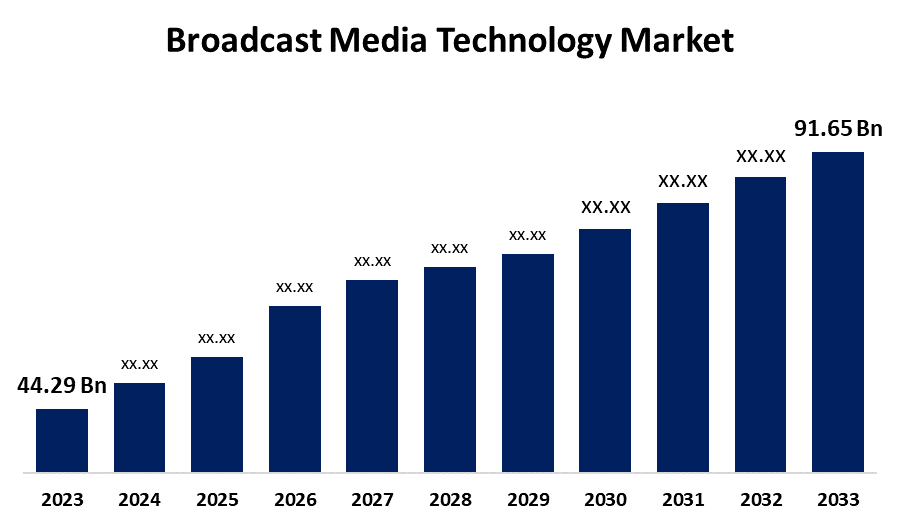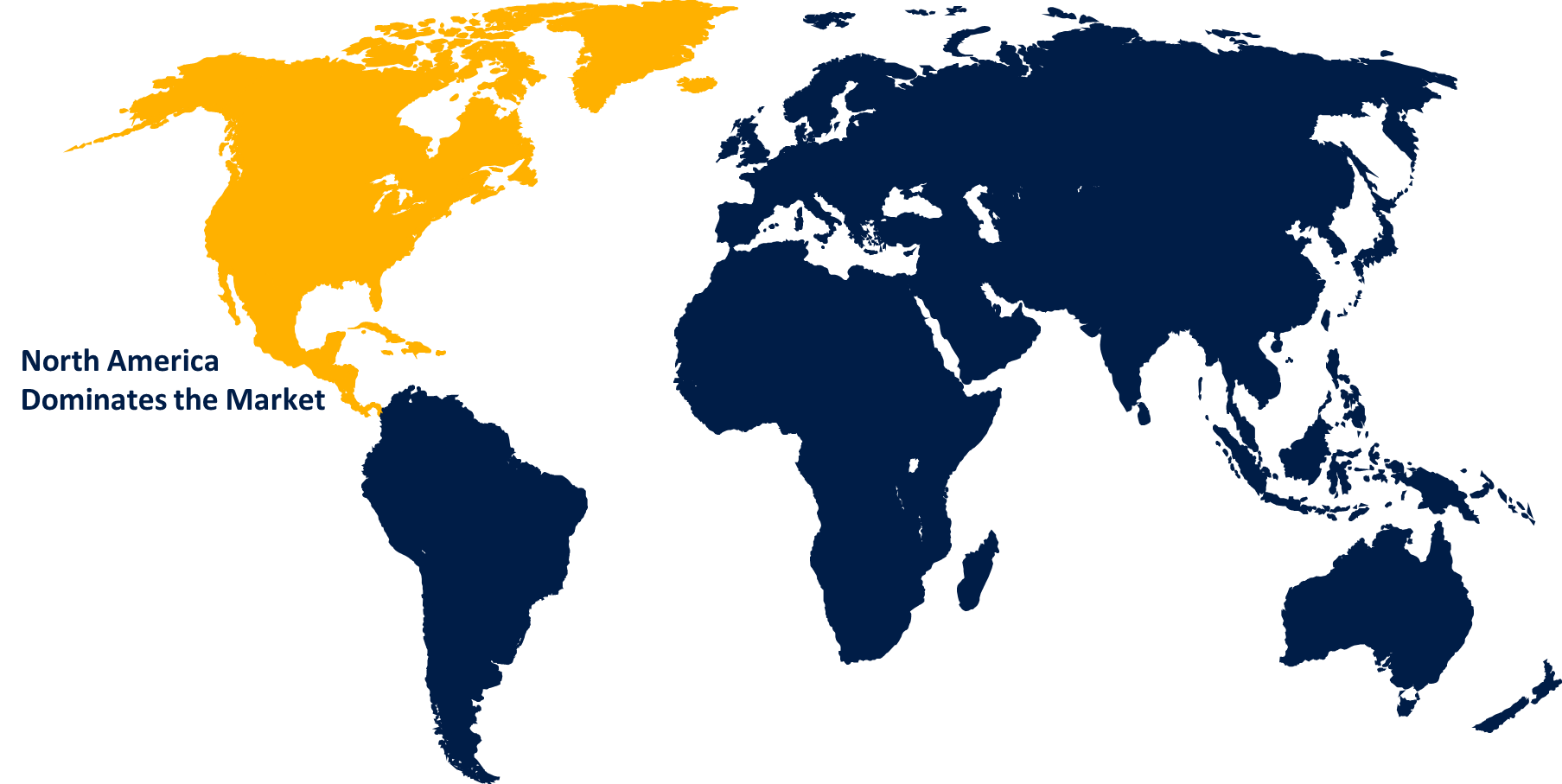Global Broadcast Media Technology Market Size, Share, and COVID-19 Impact Analysis, By Component (Software and Services), By Hosting Model (Integrated and Standalone), By End-User (Broadcast, Distributors, and OTT and IPTV), and By Region (North America, Europe, Asia-Pacific, Latin America, Middle East, and Africa), Analysis and Forecast 2023 - 2033
Industry: Electronics, ICT & MediaGlobal Broadcast Media Technology Market Insights Forecasts to 2033
- The Global Broadcast Media Technology Market Size Was Valued at USD 44.29 Billion in 2023
- The Market Size is Growing at a CAGR of 7.54% from 2023 to 2033
- The Worldwide Broadcast Media Technology Market Size is Expected to Reach USD 91.65 Billion by 2033
- Europe is Expected to Grow the fastest during the forecast period.

Get more details on this report -
The Broadcast Media Technology Market Size is Anticipated to Exceed USD 91.65 Billion by 2033, Growing at a CAGR of 7.54% from 2023 to 2033.
Market Overview
Broadcasting is that-to-many broadcast of audio or video content to an online audience by any digital mass communication media, but often one that uses the electromagnetic spectrum broadcasting wavelengths. The growing broadcast and media technology ecosystem experienced gradual progress throughout history. Broadcast media includes cable television, on-air endorsements, long-form content, multi-language computer programming, broadcast television, radio, TV/web integration, and on-demand TV. The term Broadcast Media commonly refers to the dissemination of information by radio, periodicals, television, and Bluetooth marketing, among other types of location-based transmission. Increasing demand for growing populations, urbanization, and shifting consumer preferences are all driving up demand for broadcast and media technology products and services, propelling the industry further. Furthermore, the rising demand for media and entertainment in motion or on mobile platforms is estimated to create significant potential for the worldwide broadcasting and media technology market.
Furthermore, the government is researching the viability of broadcasting TV channels live to mobile phones without a data connection, similar to direct-to-home (DTH). D2M (direct-to-mobile) technology allows mobile phone users to watch TV on their devices in the same manner as they would with a cable or DTH connection.
‘’Regulation of Broadcasting in Media’’
The Ministry of Information and Broadcasting (I&B) has taken action in conjunction with several intermediaries to block 18 OTT sites that distribute obscene, vulgar, and, in certain cases, adult material. The list also includes 19 websites, 10 applications (7 on Google Play Store, 3 on Apple App Store), and 57 social media profiles linked to these platforms that have been disabled for public use in India. Anurag Singh Thakur, Union Minister for Information and Broadcasting, has frequently highlighted the obligation of platforms to not disseminate profanity, vulgarity, and abuse under the cover of "imaginative expression." Governments in different countries have distinct content and broadcasting laws. Most countries have a permission or license system set up to regulate video streaming. For example, in Europe, advertising prescription drugs during real-time events is prohibited. On the other hand, it can be marketed in the United States.
Report Coverage
This research report categorizes the market for the broadcast media technology market based on various segments and regions forecasts revenue growth and analyzes trends in each submarket. The report analyses the key growth drivers, opportunities, and challenges influencing the broadcast media technology market. Recent market developments and competitive strategies such as expansion, product launch, and development, partnership, merger, and acquisition have been included to draw the competitive landscape in the market. The report strategically identifies and profiles the key market players and analyses their core competencies in each sub-segment of the broadcast media technology market.
Broadcast Media Technology Market Report Coverage
| Report Coverage | Details |
|---|---|
| Base Year: | 2023 |
| Market Size in 2023: | USD 44.29 Billion |
| Forecast Period: | 2023 – 2033 |
| Forecast Period CAGR 2023 – 2033 : | 7.54% |
| 023 – 2033 Value Projection: | USD 91.65 Billion |
| Historical Data for: | 2019-2022 |
| No. of Pages: | 212 |
| Tables, Charts & Figures: | 115 |
| Segments covered: | By Component, By Hosting Model, By End-User, By Region |
| Companies covered:: | Dell Inc., IBM, Quantum Corporation, Harmonic, VSN Video Stream Networks S.L, WideOrbit, Clyde Broadcast, Sencore, AVI Systems, EVS Broadcast Equipment, ACORDE Technologies S.A, Grass Valley LLC., Evertz, Rohde & Schwarz GmbH &Co KG, Others |
| Pitfalls & Challenges: | COVID-19 Empact, Challenge, Future, Growth, & Analysis |
Get more details on this report -
Driving Factors
The rapid implementation of 5G technology is propelling the broadcast and media technology market, as broadcasters use it to provide live VR broadcasts of sporting events and concerts. Media companies use 5G to deliver personalized content suggestions and enable viewers to interact with the material in real time. Regulatory Promotion government policies that encourage broadcast and media technology use, such as energy efficiency subsidies and carbon pricing, are driving market growth.
Restraining Factors
One of the main restraining factors is plagiarism and infringement on intellectual property rights are major worry for the market. Copyright infringement is the use of copied content without the copyright holder's permission, whereas copying is the unauthorized copying, distribution, or sale of copyrighted material.
Market Segmentation
The broadcast media technology market share is classified into component, solution, hosting model, and end-user.
- The software segment is expected to hold a significant market share through the forecast period.
Based on the component, the broadcast media technology market is categorized into software and services. Among these, the software segment is expected to hold a significant market share through the forecast period. Cloud is the distribution of computer services via the Internet, such as storage, processing power, and software applications. Rather than depending on local servers or personal laptops, cloud computing enables users to access and use these resources remotely via data centers run by cloud service providers.
- The standalone segment holds the highest market share through the forecast period.
Based on the hosting model, the broadcast media technology market is categorized into integrated and standalone. Among these, the standalone segment holds the highest market share through the forecast period. Due to numerous advantages of standalone including adaptability, scalability, cost-efficiency, and less vendor lock-in, among others. Organizations can modify their broadcast and media technology infrastructures to meet their needs, save money, and keep flexibility by using independent solutions.
- The OTT and IPTV segment is anticipated to grow at the highest CAGR during the forecast period.
Based on the end-user, the broadcast media technology market is categorized into broadcast, distributors, and OTT and IPTV. Among these, the OTT and IPTV segment is anticipated to grow at the highest CAGR during the forecast period. The growth of over-the-top (OTT) services will drive innovation and investment in broadcast and media technology, determining future media consumption. The development of OTT platforms including Netflix, Amazon Prime Video, and Disney+ Hotstar has changed the way viewer’s access and consume media content. These platforms are gaining prominence among viewers because of their diversified content, personalized viewing experiences, and affordable membership fees.
Regional Segment Analysis of the Broadcast Media Technology Market
- North America (U.S., Canada, Mexico)
- Europe (Germany, France, U.K., Italy, Spain, Rest of Europe)
- Asia-Pacific (China, Japan, India, Rest of APAC)
- South America (Brazil and the Rest of South America)
- The Middle East and Africa (UAE, South Africa, Rest of MEA)
North America is anticipated to hold the largest share of the broadcast media technology market over the predicted timeframe.

Get more details on this report -
North America is projected to hold the largest share of the broadcast media technology market over the forecast period. This expansion is being driven by several causes, including growing internet penetration, adoption of OTT services, rising demand for high-quality content, and government support. Internet penetration in North America is rapidly expanding, with more than 60% - 65% of the population now online. As a result, there is a large and growing market for online media consumption. Furthermore, governments around North America are making significant investments in the growth of broadcast and media technology. This helps to the formation of an enabling environment for expansion of the market.
Europe is expected to grow at the fastest CAGR growth in the broadcast media technology market during the forecast period. Subscription video-on-demand (SVOD) is becoming increasingly popular in Europe due to its flexibility and customization, which is driving market growth in this region. The availability of high-speed internet at reasonable prices, along with emerging trends in IPTV usage, is helping to sustain the broadcasting and cable TV industries' stable expansion.
The Asia Pacific region is expected to hold a significant share of the worldwide broadcast and media technology industry. The market leader's position can be ascribed to an increase in digital channels and the region's rapid transition to digital broadcasting. The increased adoption of innovative watching experiences, as well as public awareness of digital platforms such as Netflix, Amazon Prime, and Hotstar, is predicted to drive market expansion. In China, important businesses such as Baidu, Tencent, and Netflix have utilized innovative technology to improve user experience. The most recent 5G network infrastructure is predicted to transform the region's broadcast and media technology landscape.
Competitive Analysis:
The report offers the appropriate analysis of the key organizations/companies involved within the broadcast media technology market along with a comparative evaluation primarily based on their product offering, business overviews, geographic presence, enterprise strategies, segment market share, and SWOT analysis. The report also provides an elaborative analysis focusing on the current news and developments of the companies, which includes product development, innovations, joint ventures, partnerships, mergers & acquisitions, strategic alliances, and others. This allows for the evaluation of the overall competition within the market.
List of Key Companies
- Dell Inc.
- IBM
- Quantum Corporation
- Harmonic
- VSN Video Stream Networks S.L
- WideOrbit
- Clyde Broadcast
- Sencore
- AVI Systems
- EVS Broadcast Equipment
- ACORDE Technologies S.A
- Grass Valley LLC.
- Evertz
- Rohde & Schwarz GmbH &Co KG
- Others
Key Target Audience
- Market Players
- Investors
- End-users
- Government Authorities
- Consulting And Research Firm
- Venture capitalists
- Value-Added Resellers (VARs)
Recent Developments
- In August 2024, DirectOut selected Digital Media Technology Co. Ltd. (DMT) as a new distributor for its audio solutions in the region. This new agreement is a big step forward in DirectOut's expansion into Asia, reinforcing their commitment to offering world-class audio solutions.
- In April 2024, Panasonic Entertainment & Communication Co., Ltd. revealed that, in partnership with KAIROS Alliance Partners, the IT/IP platform KAIROS, which provides live production for broadcasters, has become available to clients globally.
- In May 2021, EVS Broadcast Technology introduced Xtramotion, a cloud-based system that helps transform the quality and intensity of end-user storytelling.
Market Segment
This study forecasts revenue at global, regional, and country levels from 2020 to 2033. Spherical Insights has segmented the broadcast media technology market based on the below-mentioned segments:
Global Broadcast Media Technology Market, By Component
- Software
- On-Premise
- Cloud
- Services
- Consulting
- Support and Maintenance
- Manages Services
Global Broadcast Media Technology Market, By Hosting Model
- Integrated
- Standalone
Global Broadcast Media Technology Market, By End-User
- Broadcast
- Distributors
- OTT and IPTV
Global Broadcast Media Technology Market, By Regional Analysis
- North America
- US
- Canada
- Mexico
- Europe
- Germany
- UK
- France
- Italy
- Spain
- Russia
- Rest of Europe
- Asia Pacific
- China
- Japan
- India
- South Korea
- Australia
- Rest of Asia Pacific
- South America
- Brazil
- Argentina
- Rest of South America
- Middle East & Africa
- UAE
- Saudi Arabia
- Qatar
- South Africa
- Rest of the Middle East & Africa
Need help to buy this report?